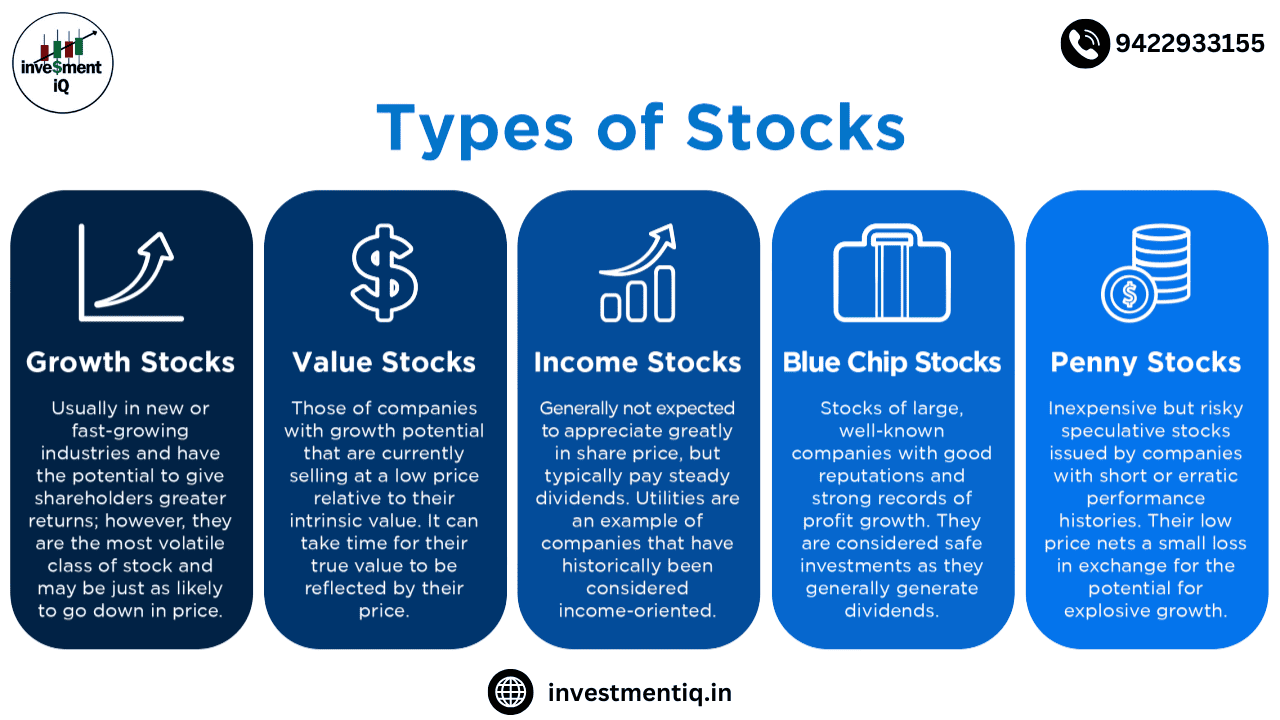The Stocks Market is the largest and most comprehensive in India. It provides an integrated platform to buy and sell shares, derivatives, mutual funds, and structured products. The platform is built around a centralized equity trading system that facilitates trading between the public and private markets.
What are the Different Types of Stocks
- Stocks are another way for you to invest in the financial market. There are several different types of stocks. These stocks can be categorized into different classes based on their fundamental set of characteristics like class and ownership.
- While this is the fundamental concept of stocks, as an investor, you need to know about the different categories of stocks to make informed decisions. Stocks can be categorized based on several parameters like class, ownership, market capitalization, dividend payout, etc.
How are Different Stocks Categorized?
There are mainly seven criterias under which the stocks are categorised. Have a look at each one of these categories that we have mentioned in the tables below:
Types of Stocks Based on Market Capitalization
Market capitalization is a way to classify stocks based on their size. Large-cap stocks are generally more valuable than mid-cap or small-cap stocks, and therefore command a higher price.
| Market Capitalization | Large-cap Stocks | The top 100 companies in terms of market capitalization. These companies generally have large market caps and are often considered to be more stable and less risky than mid-cap and small-cap stocks. |
| Mid-cap Stocks | Those ranking between 101 and 250 in the list of companies as per market capitalization. Mid-cap companies tend to have higher growth rates, but they’re also more sensitive to economic cycles and industry trends, so they can be less predictable than large-cap stocks. | |
| Small-cap Stocks | All the remaining companies. The major chunk of the market consists of small-cap companies. Small-cap stocks tend to have higher volatility than the other two categories because of the size and liquidity. |
Types of Stocks Based on Ownership
The classification of a stock depends on its rights and privileges: the preferred stock has more rights than common stock, while hybrid stocks have all the rights of common stock and none of the privileges.
| Ownership | Common Stock | Stockholders having common stocks are eligible to receive a part of the company’s profits via dividends. These are the most common types of stock in India. |
| Preferred Stock | These stocks receive promised dividends that are not available with common stocks. Also, if the company liquidates, then these stocks get preference over common stocks. | |
| Hybrid Stocks | Hybrid stocks combine features from both preferred and common stocks. The most common type is the convertible bond which allows investors to convert their bonds into equity or debt. | |
| Convertible Preference Shares | These are initially issued as preference stocks that are converted into a fixed number of common stocks at a specific time. The company can decide whether to offer voting rights with these stocks or not. | |
| Stocks With Embedded Derivative Options | Once a company issues shares, it usually doesn’t buy them back unless it deems fit. However, some companies issue stocks with embedded derivative options – call-able or put-able. In a call-able option, the company can buy back its stocks at a specific price or a specific time.In the put-able option, the company can provide the investor with an option to sell the stock back to the company at a specific price or a specific time. These are not commonly issued by companies. |
Types of Stocks Based on Fundamentals
While the market price of a stock depends on the demand and supply of the said stock in the market, most investors assess the financials of the company before buying its stock.
| Fundamentals | Overvalued Stocks | These are stocks that have a market price that cannot be justified by their earnings outlook. Hence, the market price of such stocks is higher than their intrinsic value. |
| Undervalued Stocks | These stocks have a market price lower than their intrinsic value. |
Types of Stocks Based on Price Volatility
While some investors thrive on price volatility, others prefer relatively stable stocks. Based on price volatility, stocks can be classified into the following two types-
| Price Votality | Beta Stocks | Investment analysts use a statistical measure called the coefficient of beta to find the volatility in stock prices. If a stock has a higher beta, it means that the investment risk is higher. |
| Blue-chip Stocks | These are the most stable stocks since the companies are well established. Some examples are companies like Reliance Industries, Infosys, etc. |
Types of Stocks Based on Profit Sharing
A company can either share profits by directly distributing dividends to its shareholders or invest its profits to improve and grow its business.
Based on how the company shares its profits, you get two categories of stocks-
| Profit Sharing | Income Stocks | These stocks offer consistent dividend payouts. They are called income stocks since they can add to the income of the shareholder. These stocks usually belong to companies that have strong finances and can share dividends from their profits every year. However, since the profits are distributed, these companies grow at a steady pace and are considered low-risk investments. |
| Growth Stocks | These stocks don’t pay dividends. Instead, the company reinvests its profits to grow its business. Such companies aggressively seek growth and the prices of their stocks grow rapidly. This offers the stockholder an opportunity to earn profit by selling the stocks and making capital gains. These are considered riskier than income stocks since the profits are based on the market price that can fluctuate for reasons beyond the control of the company. |
Types of Stocks Based on Economic Trends
When the stock markets react to some news about the economy, all stocks don’t move in tandem. While a certain section falls with negative news about the economy, another section seems unperturbed.
Based on the way stocks react to economic trends, they can be categorized into two types-
| Economic Trends | Cyclical stocks | These stocks move in sync with the economy. Hence, when the economic trends are negative, the prices of these stocks drop and vice versa. Investing in such stocks is usually beneficial in a booming economy. |
| Defensive stocks | These stocks don’t react strongly to economic trends. Some examples of such stocks are food, medicines, insurance, etc. These are considered safer to invest in. |
Understanding the types of stocks can help to choose the right stocks to help you meet your financial goals.
FAQs
What are the types of stocks?
- The following are the common types of stocks-
- Large-cap Stocks
- Mid-cap Stocks
- Small-cap Stocks
- Common Stocks
- Preferred Stocks
- Hybrid Stocks
- Convertible Preference Shares
- Stocks With Embedded Derivative Options
- Overvalued Stocks
- Undervalued Stocks
- Beta Stocks
- Blue-chip Stocks
- Income Stocks
- Growth Stocks
- Cyclical Stocks
- Defensive Stocks
How are stocks categorised?
There are several types of stocks which are categorized based on these following criterias-
- Market capitalization
- Ownership
- Fundamentals
- Price Volality
- Profit sharing
- Economic trends
What are the types of stocks based on market capitalization?
- Based on market capitalization, there are three types of stocks-
- Large-cap: The top 100 companies in terms of market capitalization. They have large market caps and are more stable. They have low risks.
- Mid-cap: Those ranking between 101 and 250 as per market capitalization.
- Small-cap: All the remaining companies. They have higher volatility than the other two categories.
What are income stocks and growth stocks?
Income stocks and growth stocks are types of profit sharing stocks. Income stocks offer consistent dividend payouts and can add to the income of the shareholder.
Whereas, growth stocks don’t pay dividends. Instead, the company reinvests its profits to grow its business. They are considered riskier than income stocks since the profits are based on the market price.
What are common stocks and preferred stocks?
In common stocks, the investor receives a part of the company’s profits via dividends along with voting rights to elect the board of directors. These are the most common types of stock in India.
In case of preferred stocks, the investor does not get voting right but receive promised dividends that are not available with common stocks.
you may be interested in this blog here:-
What’s the Difference Between Cyclical and Non-Cyclical Stocks?
What Are Hidden Increases and Misfortunes?




